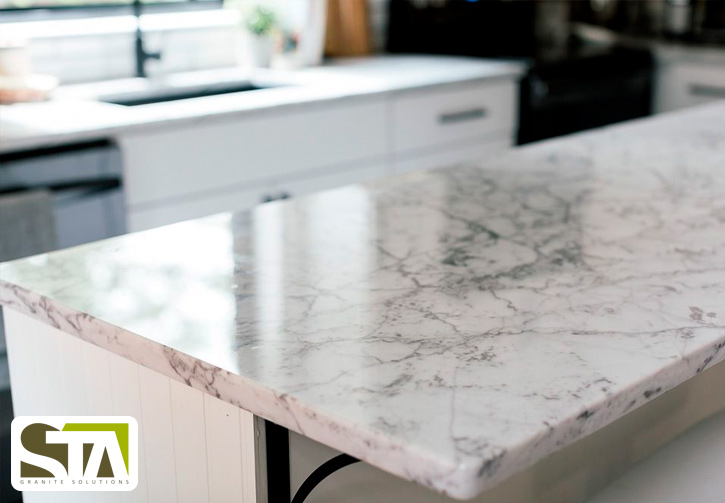POLISHED MARBLE FINISHES FOR A COUNTERTOP PT 2
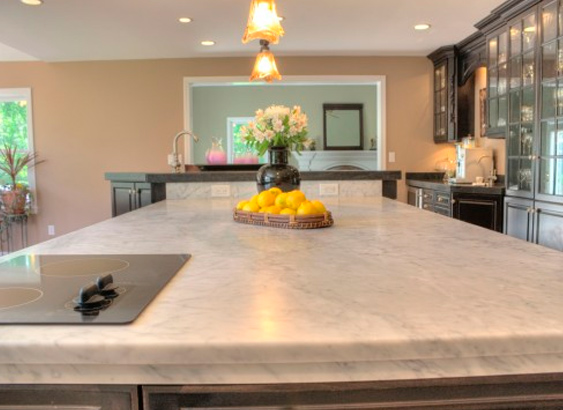
Marble's magnificence is due in part to the shiny, wondrous gleam that elegantly radiates from its deep lustrous appearance. But what is it that causes the glowing sheen that marble lovers value? In large part, it is a mineral called calcite. This mineral exists in the form of a crystal that is very shiny.
Another trait that people appreciate about marble is the color variations and the way the colors blend and exist side by side in a unified way. These two properties of marble's beauty are what get "attacked" when stains form in a marble stone. This article will discuss 4 variations of marble stains and how to treat each of them effectively. The stains we will discuss are:
• Etching on Marble
• "Color Only" Marble Stains
• Stained Etches in Marble
• Marble Rust Stains
Marble Etching, More Than Just a Stain
Often, what individuals refer to as a "marble stain" is something more. In reality, many discolorations that affect marble countertops and marble flooring are not a result of liquid staining the stone. Rather, the abnormal color of the marble is often caused by a reaction between the stone and an acidic liquid or food that results in a dull or hazy-looking spot on what appears to be the surface of the marble. What is etching and is it treatable?
The answer to the second question is yes, it is treatable. We'll get to that in a moment but first, let's talk about why etching is not the same thing as a stain. An etch in marble can be viewed as the opposite of a stain since it is subtractive and not additive.
Earlier in this article, we discussed the mineral calcite and how it is by nature a crystal. Since crystal has a glistening appearance, calcite is what makes marble look so "polished". However, acidic substances - which are common in households - dissolve calcite, the sheen-causing mineral in marble. So, when an acidic liquid like vinegar or lemon juice gets into the pores of your marble counter or floor it eats away the calcite in the marble and the resulting mark is a dull, hazy-looking spot that resembles a stain.
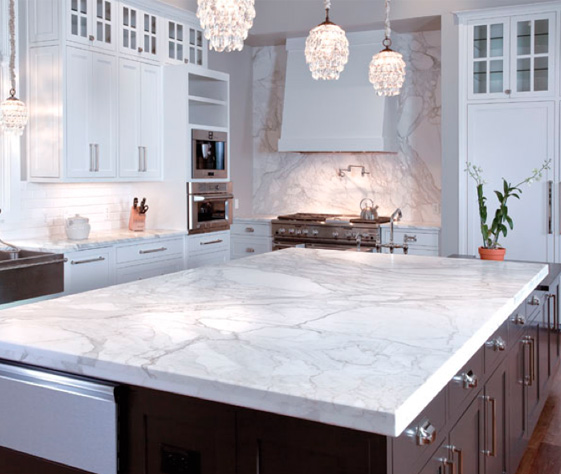
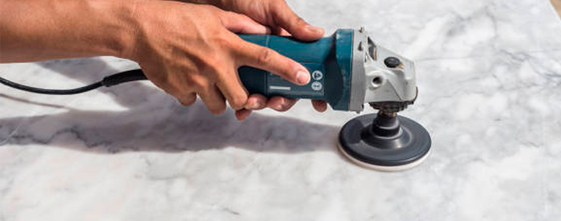
Since it was caused by a subtractive process (the removal of the calcite) the treatment process is different from that of a stain. You will need a substance that is designed to repair or restore the marble's original appearance.
Restoring your marble after it is etched is not difficult if you have the proper etch-removing powder for marble and you can follow directions. Depending on the length of time that the acid was in contact with the marble, the etch will be quickly removed or it may take some additional patience and elbow grease. However, the etch can be removed. So etching, although it discolors, is not a stain and can be treated.
The importance of having adequate equipment to cut dekton and porcelain
Why do products such as Dekton need special/different tools than those that are used for cutting granite and marble?
Material hardness is the key to understanding why you need different tools to fabricate Dekton. The material has a
The cutting process requires trimming the edges to release tensions. Then you have to follow cutting recommendations, which include using plenty of water, the proper speed, feed rate, etc. Once you follow the rules, it’s a piece of cake.


In this sense, Dekton’s edge is very easy to work with since the material is very homogeneous, and it is easy to get very good results. Any fabricator can do it well on the first attempt.
What are some common mistakes that fabricators are making when it comes to cutting this material? And, what are some common mistakes with doing edging or doing sinkholes or something?
The main mistake is trying to fabricate Dekton as if it was a granite or quartz composite. You will fail if you use the same tools, speed rates, and so on. Another common mistake is trying to cut Dekton in uneven support. It is a common source of problems too.
Sometimes people ask about what machine is best to cut Dekton. I believe the key is not the machine but the tools and proper maintenance. I have seen people with very modest equipment doing amazing things and the other way around.
7 Keys for Cutting Ultra-Compact and Sintered Dekton and Porcelain Materials







It may seem too simple or too intuitive to matter, but less than adequate water AND hoses positioned incorrectly is the most common error causing headaches among cutting these materials.
One of the more overlooked aspects of successful cutting is, to the degree that your table is not level in the horizontal plane, vibrations will occur. This unevenness can result in chipping and likely breaking the edge of your slab.
As cliche, as it may sound, choosing the right blade for the material you are processing, is critical.
While each manufacturer of ultra-compact and sintered porcelain materials may, or may not have tensioning strips built into the perimeters of each slab, if they are not removed before cutting, the slab is at higher risk of cracking or breaking.
Using the same feed rate and RPMs you may be accustomed to when cutting other materials can be a recipe for trouble. Unlike fabricating more common materials such as marble and granite, we’ve seen the most success cutting ultra-compact and sintered porcelain materials when following a systemized approach is used.
While plunge cutting tends to be of little concern for most sawyers when cutting ultra-compact and sintered porcelain materials it can pose big problems resulting in cracking or breaking your slab.
Projects requiring a sink cut-out can be an obstacle many fabricators dread. Since we already know plunging is not the ideal way to go about this, what are your options? When preparing a sink cut-out, it is advised to drill each of the four corners with a 1/2” core bit before to start initiating cutting.
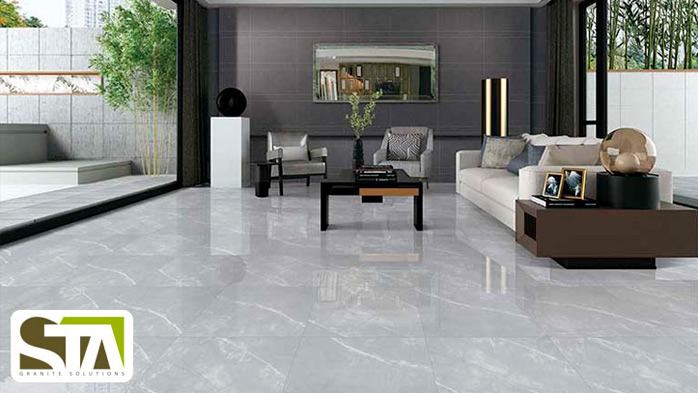
PORCELAIN FOR YOUR HOME, TILES
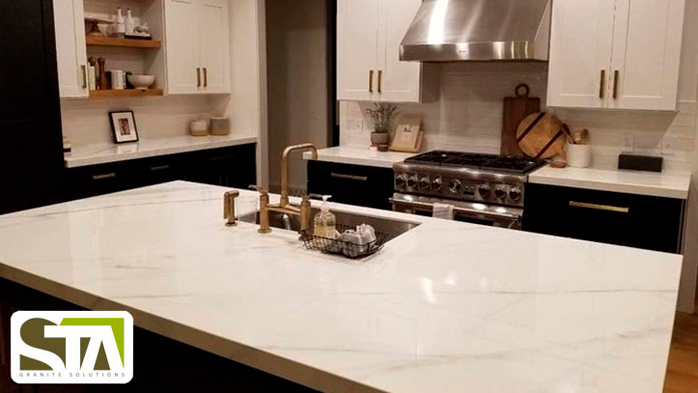
PORCELAIN FOR YOUR HOME, COUNTERTOPS FOR YOUR KITCHEN
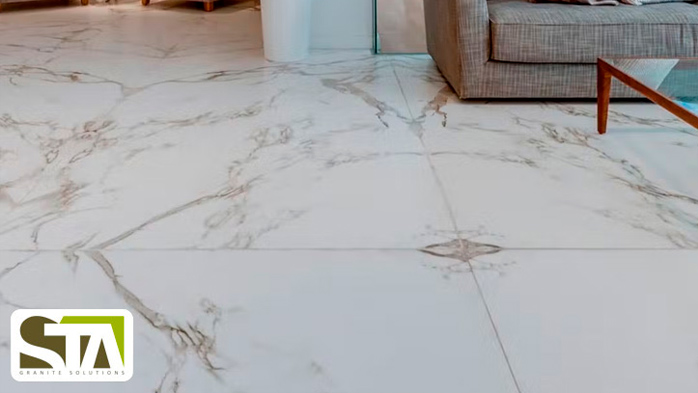
DEKTON FOR YOUR HOME, FLOORS, AND PAVEMENTS
- 1
- 2
- 3
- 4
- 5
- 6
- 7
- 8
- 9
- 10
- 11
- 12
- 13
- 14
- 15
- 16
- 17
- 18
- 19
- 20
- 21
- 22
- 23
- 24
- 25
- 26
- 27
- 28
- 29
- 30
- 31
- 32
- 33
- 34

